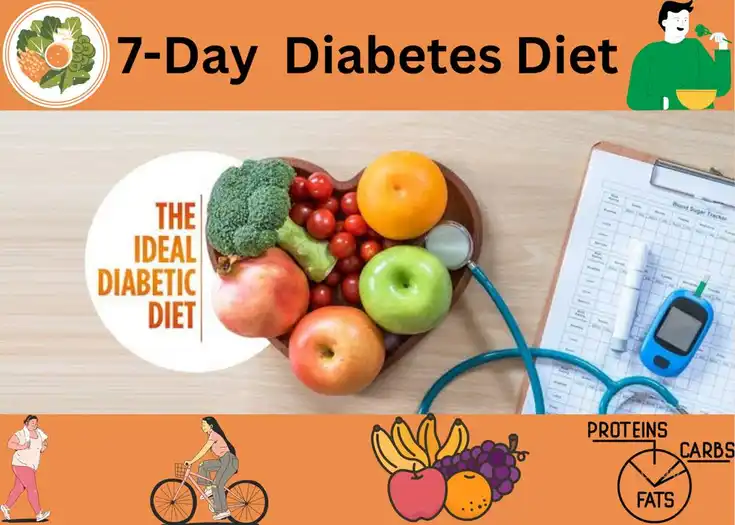“Balanced diabetes diet: control carbs, choose fiber-rich foods, and lean proteins. Portion control; monitor blood sugar. Nutrient-packed, mindful eating for lifelong health”
Precautions for Diabetes Diet
Managing diabetes through a diet is crucial for maintaining stable blood sugar levels and overall health. Here are some essential dietary precautions for diabetes:
| Carbohydrate Management: Monitor and control your carbohydrate intake, as they have the most significant impact on blood sugar levels. Choose complex carbs like whole grains, vegetables, and legumes over simple sugars. |
| Fiber-Rich Foods: Incorporate high-fiber foods like fruits, vegetables, and whole grains into your diet. Fiber slows down the absorption of glucose, preventing rapid blood sugar spikes. |
| Avoid Sugary Drinks: Cut out sugary beverages like soda, fruit juices, and energy drinks. Opt for water, herbal tea, or sugar-free alternatives. |
| Sugar Substitutes: If needed, use artificial sweeteners in moderation. Stevia, erythritol, and monk fruit are some options. |
| Meal Planning: Work with a registered dietitian to create a personalized meal plan tailored to your specific needs and preferences. |
| Hydration: Stay well-hydrated with water. Dehydration can affect blood sugar control. |
Remember that diabetes diet management varies from person to person. Regular exercise for fitness and stress management also play significant roles in diabetes care, so consider incorporating these into your overall diabetes management plan.
step-by-step guide for a 7-day Diabetes Diet plan
Creating a 7-day diabetes diet plan can help you manage your blood sugar levels effectively. Here’s a step-by-step guide to help you get started:
Day 1: Meal Planning and Preparation
| Grocery Shopping: Make a list of diabetes-friendly foods, including lean proteins (chicken, fish), whole grains (brown rice, quinoa), and plenty of vegetables. |
| Assess Your Needs: Consult a registered dietitian to determine your daily calorie and carbohydrate goals based on your age, weight, activity level, and diabetes type. |
Day 2–7: Daily Meal Planning
| Breakfast: Start your day with a balanced meal that includes whole grains, protein, and healthy fats. Example: oatmeal with almond butter and berries. |
| Snacks: Plan for healthy snacks between meals to prevent blood sugar spikes. Opt for Greek yogurt with nuts or veggies with hummus. |
| Lunch: Include lean proteins and non-starchy vegetables in your midday meal. Example: grilled chicken salad with a vinaigrette dressing. |
| Afternoon Snack: Choose a low-carb option like cottage cheese or a handful of almonds. |
| Afternoon Snack: Choose a low-carb option like cottage cheese or a handful of almonds. |
| Dinner: Keep portions controlled, emphasizing lean proteins and vegetables. Example: baked salmon with steamed broccoli and quinoa. |
| Hydration: Stay hydrated with water or herbal tea throughout the day. |
Day 7: Review and Adjust
| Blood Sugar Monitoring: Throughout the week, monitor your blood sugar levels regularly to assess how your meals affect them. |
| Reflect and Adjust: Analyze your week’s data and note any patterns. Adjust your diet plan accordingly with your dietitian’s guidance. |
General Tips:
- Carb Counting: Be mindful of your daily carbohydrate intake and evenly distribute it across meals and snacks.
- Exercise for Fitness: Incorporate regular physical activity into your routine, as it complements your diet in managing diabetes.
- Medication Management: If you’re on diabetes medication or insulin, consult your healthcare provider for adjustments based on your diet changes.
Remember, this plan is just a starting point. Personalize it with your dietitian to meet your specific needs.
Strategies for Diabetes Diet Food Scheduling
Effective diabetes diet food scheduling is essential for maintaining energy levels, managing weight, and promoting overall well-being. Here are some eye-catching strategies:
| Balanced Breakfast Boost: Kickstart your day with a balanced breakfast rich in protein, fiber, and healthy fats for sustained energy. |
| Snack Smartly: Plan nutritious snacks like nuts, yogurt, or fruit to keep hunger at bay between meals. |
| Mindful Eating Moments: Practice mindful eating by savoring each bite, appreciating flavors, and recognizing when you’re full to avoid overindulging. |
| Timing is key: Space meals evenly to maintain stable blood sugar levels, preventing energy crashes and cravings. |
| Flexi-Schedule: Adjust your eating times to fit your lifestyle while maintaining consistency for better metabolism regulation. |
These catchy strategies promote mindful eating, balanced nutrition, and long-term health, making food scheduling a rewarding and enjoyable part of your daily routine.
Calorie Management for Diabetes Diet
Creating a calorie plan for a diabetes diet is essential to managing blood sugar levels effectively. Here’s a comprehensive guideline:
Total daily calories:
- Aim for 1,500 to 2,000 calories per day, but individual requirements may vary based on factors like age, gender, activity level, and weight goals.
Macronutrient Distribution:
- Carbohydrates: 45–60% of daily calories.
- Protein: 15-20% of daily calories.
- Fats: 25–30% of daily calories.
Carbohydrates:
- Focus on complex carbs from whole grains, vegetables, and legumes.
- Limit simple sugars and refined carbohydrates.
Proteins:
- Choose lean sources like poultry, fish, tofu, and beans.
- Adequate protein intake helps stabilize blood sugar and keeps you feeling full.
Fats:
- Prioritize healthy fats from sources like avocados, nuts, seeds, and olive oil.
- Avoid trans fats and limit saturated fats.
Portion Control:
- Monitor portion sizes to avoid overeating. Use measuring cups and food scales if necessary.
Meal Distribution:
- Spread calories evenly across meals and snacks.
- Aim for three balanced meals and 1-2 healthy snacks per day.
Regular Monitoring:
- Check blood sugar levels regularly and adjust your plan accordingly.
Individualized Guidance:
- Consult a registered dietitian or healthcare provider to personalize your calorie plan based on your specific diabetes type, medications, and health goals.
Calories from fruits
Calories from fruits vary based on the type and portion size. Here’s a breakdown:
- Low-Calorie Options: Many fruits are naturally low in calories, making them ideal for weight management and calorie-conscious diets.
- Berries: Berries like strawberries, blueberries, and raspberries typically contain 30–60 calories per cup.
- Citrus Fruits: Oranges, grapefruits, and clementines range from 40 to 80 calories each.
- Apple and Pear: Medium-sized apples and pears contain around 95–100 calories.
- Melons: Watermelon and cantaloupe have approximately 30-50 calories per cup.
- Bananas: A medium-sized banana provides roughly 105–120 calories.
- Higher-Calorie Fruits: Avocados and coconut are fruit-based but are higher in calories due to their healthy fat content.
Fruits are nutrient-dense, offering vitamins, minerals, and fiber alongside their natural sugars. While they’re a valuable part of a balanced diet, portion control is essential for individuals managing calorie intake or monitoring blood sugar levels. Incorporating a variety of fruits can provide essential nutrients while contributing to a healthy and satisfying diabetes diet.
No, a diabetes diet and a keto diet are not the same. They are distinct dietary approaches with different objectives
Diabetes Diet vs. Keto Diet
Diabetes routine:
- Aimed at managing blood sugar levels for individuals with diabetes.
- Focuses on controlling carbohydrate intake, choosing complex carbs, and monitoring portion sizes.
- Emphasizes a balanced intake of proteins, healthy fats, and fiber-rich foods.
- May include fruits and certain whole grains in moderation.
- Tailored to individual needs, it often involves meal planning with a registered dietitian.
Keto Diet (Ketogenic Diet):
- A high-fat, very low-carbohydrate diet is designed to induce ketosis, a metabolic state where the body burns fat for energy.
- Severely restricts carbohydrates, typically to 20-50 grams per day.
- Promotes a high intake of fats, often from sources like avocados, nuts, and oils.
- Includes moderate protein consumption.
- Not primarily designed for diabetes management but may have some impact on blood sugar control.
- Should be followed with caution, especially by individuals with diabetes, and under medical supervision.
While both the diabetes diet and the keto diet involve carbohydrate control, their overall principles and objectives are different, making it important to choose the one that aligns with your specific health goals and needs, ideally under the guidance of a healthcare professional.
Source: ZoxPR

